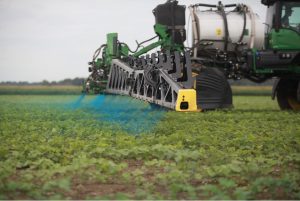A Look at Current and Future Soybean Research Across Two States in the South
NORTH CAROLINA
A Q&A with Jeff Chandler, research coordinator for the North Carolina Soybean Producers Association
Jeff Chandler
Q: What are some of your current and main research studies?
A: The North Carolina Soybean Producers Association invests checkoff assessment funds in soybean research through a diverse set of disciplines that impact soybean production from agronomics to pest management and climate resiliency.
• Insect pest damage thresholds need to be updated in North Carolina and one research project is looking to quantify the impact of different defoliation treatments on final yield, particularly in early planted situations and current varieties. This work will be used to update treatment thresholds for foliar feeding insect pests in soybeans.
• Evaluating the impact of tillage treatments and cover crops on soybean yield is a current research project of particular importance with managing herbicide resistant weeds and soil hard pan issues.
• There have been exciting discoveries through our research with the use of UAV imagery to estimate soybean maturity and stand counts.
• A dynamic tool was developed this year to catalog problems observed in the field through a website that can be accessed by agents, consultants, and growers to see what new and emerging problems are occurring in their local area at any given time during the season.
• Saltwater intrusion is a concern to growers near the coast. Recent research has investigated the impact on yield under elevated soil saltwater content.
• Biologicals are all the rage, and we are supporting research to evaluate biological and alternative products to manage sting and root-knot nematodes.
• Surveys of growing regions around the state are being done to determine the quantity and species of stink bugs present as well as natural enemies to these pests.
• Research screening of soybean varieties for performance under drought stress, ideal soil moisture, and excessive water stress has demonstrated that genotypes and maturity groups respond differently to these climate conditions. The results will be used to advise growers on variety selection on drought or flood prone soils.
• Physiological traits such as heat tolerance are associated with specific genes and current research is designed to identify the target genes that can improve heat tolerance through breeding.
Stand count algorithms were most accurate when UAV imagery was collected 20 to 30 days after planting. The timing and altitude of the flights were the most significant factors influencing the accuracy of the UAV-based stand counts. Plants should be fully emerged so that individual plants are clearly visible in the UAV imagery.
Q: What groups/individuals do you work with the most? How do you go about selecting them as partners in research efforts?
A: Most of our checkoff research investments are made with faculty at NC State University. Research proposals are solicited in the fall for the following season’s research work. Proposals are then reviewed and selected for funding in a competitive process by our farmer led board of directors. Projects having the greatest potential to positively impact soybean profitability in North Carolina and address current research priorities are most likely to be successful. We also accept proposals from institutions other than NC State.
On-farm research is an important component of the soybean research enterprise in North Carolina. One strategy for this is working in collaboration with county Extension agents and grower cooperators to conduct larger scale field trials that complement the more intensive, small-plot research typically done by university faculty but at “field scale” and in local communities throughout the state. In 2023, we had 30 on-farm trials in 20 counties evaluating biological products and foliar fungicides. I especially appreciate the opportunity to work with farmers through this program to engage them in current research priorities and get their feedback on what issues are important to their farm. Farmer cooperators are identified through the county Extension agents who work with the farmer to implement, monitor, and collect data from these projects.
Sometimes, there are gaps in our research program that are not addressed through university faculty research or our on-farm program. In these instances, we have contracted with private consultants to conduct third-party research trials to address these knowledge gaps in our program.
Beans Gone Wild is an NCSU application developed to catalog issues seen in the soybean fields across the state.
Q: What do you hope to learn from these research efforts, and how do you plan to implement your findings in the future?
A: What we hope to learn are innovative production practices that enhance soybean profitability. Another key attribute of these research projects is building the knowledge base that Extension utilizes to advise growers on research-based decision making in selecting their production practices. Research outcomes are shared with soybean producers through our annual research report, newsletters, and social media posts. These research discoveries are also shared through Extension at grower meetings.
Q: What are some future projects you are looking forward to?
A: One potential project we have been in discussion about is use of robotics to quantify and mitigate deer damage to soybeans. In this project, a visual monitoring system would incorporate thermal cameras in the field to detect deer in real time and relay that data through wireless communications to a robotic dog that would autonomously chase deer out of the field.
Mixed nature of soybean response to three treatment exposures in 2022. Solid dots are the average yield for Group IV, V, and VI varieties (n=18). Soybean yield potential in different environments may be explained by varietal growth characteristics and the timing and duration of stress.
Q:What has been the most impactful study you’ve conducted thus far? Why?
A: One major research effort for us over the past several years has been a comprehensive evaluation of planting date x maturity group interactions in diverse environments across the state. North Carolina has the blessing and the challenge of many different production regions in the state, each responding differently to planting date and maturity group selection. One of the goals of this project is to produce a robust data set of yields based on multiple planting dates and maturity groups in multiple environments around the state in each of the past five years. The outcome of this work will be an interactive tool, launched in early 2024, that a grower could use to select the planting date and maturity group expected to perform best in their region of the state based on this research.
— Cassidy Nemec
The post The Importance of the Check-off: North Carolina appeared first on Soybean South.
[#item_full_content]





